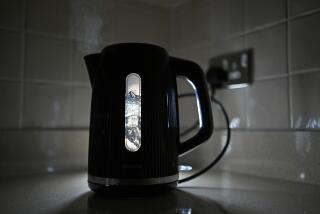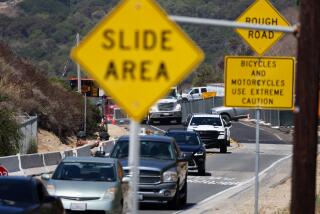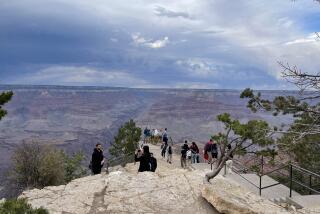San Diego Residents Asked to Cut Water Use After Aqueduct Break
SAN DIEGO — Several hundred thousand residents in southeast San Diego County were admonished Saturday to reduce water consumption by at least half--and in some neighborhoods to brace for intermittent water stoppages--because of a break in one of the five main aqueducts that bring imported water here.
Three water districts that serve suburban cities and rural neighborhoods declared a Stage 4 water emergency, meaning that outdoor watering and car washing are banned and customers are urged to cut back on water use indoors.
Water officials also were turning off meters that serve crop irrigation lines and construction sites.
The break in the aqueduct occurred Friday. Officials said the rupture of the 84-inch aqueduct--which normally pours 70 million gallons of water daily into the area--might not be repaired until next Friday. Workers were awaiting a replacement 20-foot steel pipe section being fabricated in Los Angeles.
“Once it’s delivered, we’ll work around the clock to get it in,” said Lester Snow, general manager of the San Diego County Water Authority, which sells wholesale water to the county’s individual public water districts.
He said cause of the break in the reinforced concrete pipe, in the Scripps Ranch area of San Diego, was still unknown Saturday.
He said lessons are being learned from the incident: just how well San Diego might fare if an earthquake ruptured one or more of the five pipelines that bring imported water into San Diego from Northern California.
“This is a good illustration of what we’d have to do if we had an earthquake--by asking the public to immediately reduce its water consumption and by asking the various water agencies to share their water through inter-connections,” he said.
Among those affected by the waterline break were residents of the cities of Santee, El Cajon, La Mesa and Lemon Grove, and the unincorporated communities of Rancho San Diego, Spring Valley, Lakeside, Alpine and Otay along the U.S.-Mexican border.
Within the city of San Diego, only residents in the northern suburb of Rancho Bernardo might experience a drop in water pressure, Snow said.
Although Snow said there should be no serious water shortages if customers cut back on water and the affected agencies are able to buy water from neighboring districts--as they were doing Saturday--other water officials still made dire pronouncements.
“We’re at a Stage 4 alert,” said Leslie Melenchuk, spokesperson for the Padre Dam Municipal Water District. “And there is no Stage 5. This is as bad as it gets.”
Said Charlie Cassens, spokesman for the Otay Water District, the hardest hit: “We have enough water in our storage tanks to keep us until Wednesday, but we could run out of water, unless we get every customer to cut back to only the most essential water use.
“There may be some areas in our district that will experience lower water pressure, and there is the possibility of intermittent interruptions in our water service as we do some creative ‘valving’ to keep our reservoirs from going dry.”
Efforts were under way Saturday to purchase water from other districts. Still, sitting literally at the end of the water pipeline from Northern California to the Mexican border, the Otay district officials said they weren’t bluffing when asking customers to cut back.
“We’re trying to get the word out to everybody that this is no drill or the result of the drought or any political maneuvering,” Cassens said. “This is an actual, physical break in a main artery that brings imported water to San Diego County. This is most certainly an example of what could happen to the region in an earthquake.”
Cassens said enforcement officers were patrolling the district to look for water-wasting scofflaws, and he asked residents to take action if they see people not responding to the call for strict conservation.
More to Read
Sign up for Essential California
The most important California stories and recommendations in your inbox every morning.
You may occasionally receive promotional content from the Los Angeles Times.









